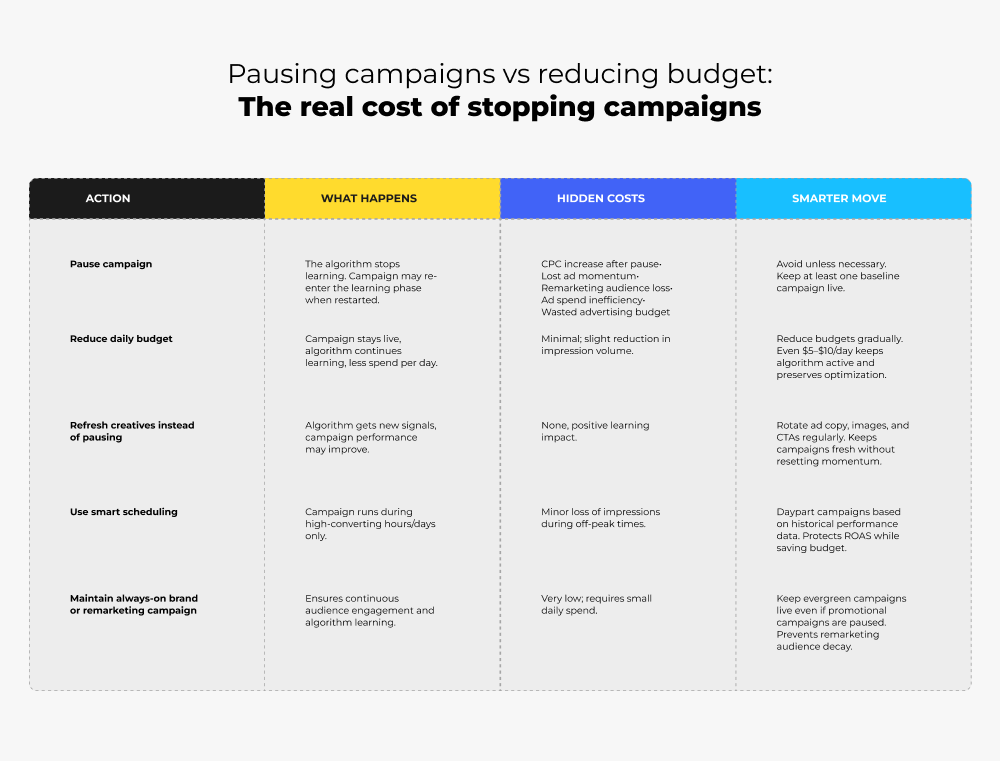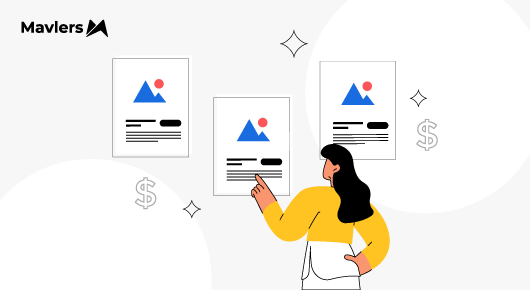So, as a paid search professional working for a brand/business, you know that moment when a client drops the classic line: “Let’s pause campaigns for a bit, just until things pick up”?
If you’re anything like us, your brain immediately goes through a mental checklist of red flags.
Your gut says, “Oh no. Not this.” The pause button always feels innocent, you know, a sliver of momentary relief, a way to control spending, but anyone who’s spent real time in paid search, been in the trenches, knows better.
The truth is that pausing Google Ads isn’t just stopping spend. It’s akin to interrupting the flow of learning, killing momentum, and quietly sowing inefficiency. The worst part? It’s invisible.
You might not notice the damage on a daily report, but it’s there; it sneaks up in the form of a slow decline in performance, data quality, and ROI, which shows up weeks later in higher CPCs, smaller remarketing pools, and a wasted advertising budget.
Stick with us, because with our rich repertoire of 13+ years of expertise in the SEM sphere, we’re going to talk about why hitting pause is more expensive than you think, how it affects algorithm learning, and what you can do instead.
By the end, you’ll see that consistency is quite the uncrowned hero of campaign performance, and sometimes, less obvious choices save more money than an abrupt stop.
An insight into why hitting the pause button might feel like a smart decision, but often isn’t one!
Let’s start with empathy. Pausing a campaign might seem like a logical move from the outside. Maybe your performance dips, the client freaks out about overspending in digital ads, or you’re between product launches. Those reasons all make sense.
- “Conversions are down, let’s stop until we figure out why.”
- “Our ad budgets are underperforming this quarter; let’s pause to save money.”
- “We’re in between promotions; why spend anything now?”
Sure, this reasoning might sound smart… if you’re considering today’s spending.
But here’s where most marketers get it wrong: ad platforms like Google, Meta, and LinkedIn aren’t static billboards. They’re machine learning ecosystems that thrive on continuity.
Every click, impression, and conversion is a data point that feeds the system, teaching it who your best customers are, where they hang out, and when they convert.
When you hit pause, you don’t just stop showing ads. You end up stopping that data flow. And when you eventually restart, the algorithm doesn’t greet you like an old friend. On the contrary, it squints at you like, “Wait… remind me again who these people are?”
That’s the harsh reality of the impact of pausing campaigns. It’s invisible, slow, and expensive.
Understanding algorithm learning ~ Quite akin to the dance of dating!
In simple terms, machine learning in ad platforms works through pattern recognition. Over time, the algorithm learns:
- Who is likely to click or convert
- Which devices, placements, and times drive the most value
- How to optimize bids dynamically for high-performing users
The more consistent the campaign, the smarter and cheaper it becomes. But consistency is key.
One may think of it like dating. At first, you’re figuring things out. “Do they like long emails or short texts?” “What time of day do they reply?” The more you engage consistently, the better you understand each other.
Now, imagine you ghost your situationship for a month. When you return, you have to rebuild rapport from scratch (and probably come up with a credible excuse for the no-show!).
That’s exactly what happens when you pause Google Ads. Every stop-and-start interrupts learning, resets momentum, and costs money (and effort) to rebuild.
Decoding the hidden costs of pausing campaigns
As discussed above, pausing comes at a cost, not the kind you can see immediately on a dashboard.
1. Learning phase reset
Every time you pause and restart, campaigns re-enter the dreaded learning phase. You can expect inconsistent delivery, confused targeting, and, yes, that classic CPC increase after a pause. You’ll feel like you’re back at square one, but this time with money flying out the window.
2. Lost ad momentum
Momentum is everything in paid search. Campaigns gain efficiency and optimization power over time. Pause them, and all that hard-earned momentum evaporates. That’s lost ad momentum in action, and rebuilding it often takes weeks of extra spend.
3. Remarketing audience loss
Do you remember those warm audiences you nurtured for months?
Well, when you stop showing ads, they might start slipping away. Pixels stop collecting data, cookies expire, and by the time you restart, your remarketing audience may have moved on… to a competitor. Yeah, that’s kinda painful.

4. Budget inefficiency in ads
If you think pausing saves money, well, on the contrary, it often costs more to recover performance than what you “saved.” That’s ad spend inefficiency, plain and simple.
5. Reporting chaos
Stop-start campaigns create jagged, unreliable data. Metrics spike, dip, and trendlines look like rollercoasters. Decision-making becomes guesswork, and what appears to be underperformance might actually be a recovery lag, fueling underperforming ad budgets.
Let’s put it in perspective with a table. One may think of it as a cheat sheet for handling budget pressure without sabotaging campaigns:

Exploring alternatives to pausing Google Ads campaigns
Instead of pausing campaigns, seasoned SEM pros consider these strategies to manage budget without disrupting performance:
- Consider lowering budgets, instead of stopping ads
You may think of it like dimming the lights instead of shutting off the power supply to the whole house. Similarly, instead of pulling the plug on your campaigns, try to gently reduce daily spend. Even a small budget keeps the algorithm humming and learning. This way, you’re still collecting valuable data, avoiding CPC spikes after pause, and keeping ad momentum intact.
2. Refresh creatives regularly
A dip in performance doesn’t necessarily signal it’s time to hit pause. Try swapping out old ad copy, rotating images, or tweaking calls-to-action. Fresh creative signals keep the algorithm busy, improve engagement, and prevent your campaigns from going stale, all without wasting advertising budget.
3. Schedule ads in a smart way
If your analytics indicate that certain hours or days underperform, don’t turn off the campaigns entirely; instead, schedule them to run when conversions are most likely to occur. It’s a simple hack to save money, protect remarketing audiences, and keep campaigns efficiently spending ad budgets where they count.
4. Keep an evergreen campaign up & running
Even when you choose to cut back on promotions, it’s recommended to maintain at least one always-on brand or remarketing campaign.
This simple step ensures that your audience still sees you, thereby preserving your remarketing audience pools and allowing the algorithm to continue learning. It’s like leaving a nightlight on, which runs on minimal energy and guarantees maximum continuity
5. Giving stakeholders buy-in on the journey
Generally, most ad campaign pauses happen because someone higher up thinks it’s saving money. However, a quick reality check goes a long way in explaining how underperforming ad budgets, lost ad momentum, and inefficient campaign spending can actually make short-term savings a long-term drain. Once stakeholders understand the hidden costs, making smarter budget decisions becomes easier.
Choosing to stay consistent over pulling the plug on campaigns abruptly
To call a spade a spade, consistency compounds. Campaigns that run steadily gather more data, optimize more quickly, and achieve a better ROI over time. On the other hand, stop-start behavior disrupts this flow, creating inefficiencies that are expensive to fix.
For marketers and SEM professionals, the lesson is crystal clear:` don’t pause campaigns, instead choose to adjust, optimize, and keep the learning going.
Every dollar spent should contribute to long-term efficiency, not wasted restart cycles.
The road ahead
Additionally, as the holiday season approaches, there is something that you, as a paid search professional, must be aware of and consider. Yep, we are indeed referring to seasonal fatigue that might affect your holiday ads’ ROAS. Need more clarity? Then, this detailed guide should be your next pit stop: Seasonal fatigue in paid media —the hidden reason holiday ads don’t always win.


Pooja Ghariwala - Subject Matter Expert (SME)
Pooja Ghariwala is an experienced SEM Analyst with over five years of expertise in digital marketing. In her current role, she manages and optimizes campaigns across platforms like Google Ads, Meta Ads, and LinkedIn Ads, ensuring her clients' marketing goals are met. She directly interacts with clients to address their queries and provide strategic guidance.
Naina Sandhir - Content Writer
A content writer at Mavlers, Naina pens quirky, inimitable, and damn relatable content after an in-depth and critical dissection of the topic in question. When not hiking across the Himalayas, she can be found buried in a book with spectacles dangling off her nose!
Link building tools in 2025: The real costs, trade-offs & what you should actually use
The hidden half of your paid media: Why ignoring the dark funnel could be killing your ROAS